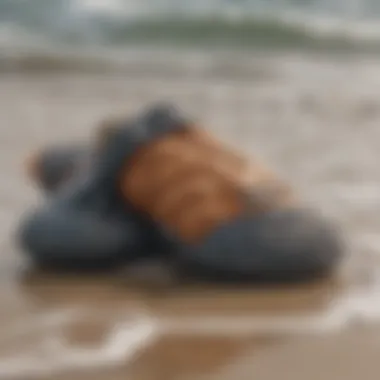Surfer's Guide to Surf Mittens: Comfort and Performance


Intro
Surfing in cold water can be a thrilling yet daunting experience. While the waves may be perfect, the bite of chilly temperatures and frigid winds can dampen your spirits. Enter surf mittens – a simple yet effective solution to keep your hands warm and functional while you ride the waves. This article will dig deep into the world of surf mittens, examining how they enhance comfort and boost performance, especially in colder conditions.
Imagine paddling out into the ocean, the cool water splashing on your face, your hands—protected and toasty—gripping the board tightly. Surf mittens are not just any accessory; they are vital tools for surfers dedicated to maximizing their time on the water. We will explore the various materials and styles available, practical tips on selecting the right pair, and methods to maintain them, ensuring your surfing experience remains enjoyable.
By the end of this guide, you'll have a thorough understanding of why surf mittens matter, from their functional benefits to the aesthetic flair they add to your surfing gear. Let's dive right into the essential insights about gear and how to make this accessory work for you.
Foreword to Surf Mittens
The world of surfing comes with its own set of challenges, particularly when it comes to braving the elements. Among the various accessories that a surfer might carry, surf mittens often get sidelined in favor of flashier gear. However, their significance cannot be overstated. Surf mittens not only provide essential hand protection but also enhance one’s overall performance in chilly waters. This section will dive into the importance of surf mittens in detail.
Understanding Surf Mittens
So, what exactly are these mittens that beat the ordinary gloves? Surf mittens are specially designed handwear meant for cold-water surfing. Unlike regular gloves, they feature a unique construction that's aimed at keeping your fingers warm and ensuring that they remain functional while gripping the board. Typically, they come in two styles: full-fingered mittens and the lobster claw variety that separates the thumb from the other fingers. This setup offers a blend of warmth and dexterity, giving surfers a better grip on their boards without compromising warmth.
One might wonder about the materials used in crafting these mittens. Most are made from neoprene, which is known for its insulation properties and flexibility. However, some brands have started experimenting with other materials for specific features—like enhanced durability or flexibility.
In essence, understanding surf mittens means recognizing their role as a bridge between comfort and functionality. They are simply more than an accessory; their thoughtful design caters to the unique demands of surfing.
The Need for Hand Protection
Surfing may appear to just be a fun activity, but facing the ocean’s elements without proper hand protection can lead to serious discomfort. Cold water can sap your energy faster than a snitch at a poker game, making it tough to focus on catching waves. The chilly stings of the water can lead to numb fingers and decreased grip, putting you at a disadvantage on the surfboard.
Moreover, constant exposure to saltwater can also lead to skin irritations and conditions like chapping, ultimately hindering your performance. Here’s why hand protection becomes vital:
- Improved Grip: Cold hands make it harder to hold onto that board while paddling through the waves.
- Increased Comfort: No one wants to be distracted by feeling like their fingers are about to fall off, right?
- Longer Surf Sessions: Being warm means staying out in the water longer. More time catching waves, less time shivering.
"Surf mittens not only shield your hands from the biting cold but unlock doors to a more enjoyable surfing experience."
Materials Used in Surf Mittens
Understanding the materials used in surf mittens is crucial, as they largely determine the comfort, durability, and overall effectiveness of these accessories in the surfing milieu. Surf mittens are not just mere appendages to keep the fingers warm; they play a significant role in ensuring optimal performance while paddling out on icy waters. With advancements in material technology, the choices available vary widely, each tailored for specific conditions and surfer preferences.
Neoprene: The Standard Choice
Neoprene is to surf mittens what steel is to construction—essential and robust. This material is widely recognized for its insulating properties and flexibility. When surfers plunge into frigid waters, neoprene works to trap body heat, delaying the dreaded chill from seeping in. The elasticity found in neoprene gives surfers a natural feel for their board, essential during those critical moments when balance can make or break a ride.
Due to its resilience, neoprene resists wear and tear, a vital attribute for those who engage in regular surfing. The various thickness options allow for customization according to personal preferences and surf conditions, making it a go-to for many.
Alternative Materials
While neoprene reigns supreme, alternative materials have carved a niche in the surf mitten domain. Let's delve into a few that have gained popularity among surfers.
Polyester
Polyester is increasingly seen in surf mittens, particularly for lining or as part of a composite product. Its lightweight nature makes it a favored option, especially among surfers looking to maintain agility in their movements. This material dries faster than traditional neoprene, ensuring that the mittens do not become waterlogged after a long session in the surf.
A notable advantage of polyester is its resistance to fading and its capacity to withstand repeated exposure to sunlight. However, while it offers good thermal protection, it may not provide the same level of insulation as neoprene, particularly in extremely cold conditions.
Rubber
Rubber has found its footing in surf mittens primarily for its grip-enhancing properties. Its grippy texture provides a substantial advantage, allowing surfers to maintain hold of their boards even in wild conditions. This is especially relevant during a spirited wave or turbulent waters.
Although rubber is incredibly sturdy and offers a unique feature of slip resistance, it does lack the flexibility that neoprene boasts. Furthermore, rubber mittens might be less forgiving as temperatures drop, meaning they aren’t the best choice for colder waters if you prioritize warmth over grip.


Synthetic Blends
Synthetic blends represent a fascinating take on mitten design. By fusing various materials, manufacturers aim to achieve an optimal balance between durability and comfort. A hybrid of neoprene and other fabrics enhances breathability while providing decent thermal insulation during colder days at sea.
One key characteristic of synthetic blends is their resilience against the elements. These mittens often feature quick-drying properties, making them ideal for aggressive surfers who hit the beach multiple times a week. However, one might find that sometimes these blends can be pricier than their single-material counterparts, which could be a deciding factor for some.
Choosing the Right Surf Mittens
Choosing the right surf mittens is essential, especially for surfers looking to maintain comfort and effectiveness in cold conditions. It’s about looking beyond just the initial design; it’s about how well these accessories can enhance the surfing experience. Picking the right mittens takes into account several factors, such as fit, design, and brand offerings. Each detail plays a crucial role in ensuring that a surfer’s hands stay warm, protected, and ready to grip the board tightly, even in the most challenging waters.
Sizing and Fit
When it comes to surf mittens, size and fit are not just minor details to gloss over. An ideal fit means that the mittens should hug your hands just right without being too tight or too loose. If they’re too big, you might lose grip on your board during a wave, and if they’re too tight, they could restrict blood flow, making your fingers cold and unresponsive.
The fitting process can be pretty straightforward. Measure from the base of your palm to the tip of your longest finger. Most brands offer sizing charts that can help translate your measurements into the right size. Additionally, consider the presence of wrist straps or adjustable closures, which can further refine the fit. A snug fit prevents water from seeping in, while allowing a bit of flex will help you retain mobility.
Design Variations
Surf mittens come in various designs, each catering to different preferences and requirements of surfers. Understanding these variations can help you make an informed choice and truly enjoy your time on the water.
Full-finger vs. Lobster Claw
The debate between full-finger mittens and lobster claw designs is quite prevalent among surfers. Full-finger mittens cover all fingers completely, providing maximum warmth. This style is favored particularly in extreme cold, as it prevents any cold water from touching skin. Those using full-finger designs appreciate the warmth and dexterity they offer. However, some might criticize them for limiting grip strength, as there are sometimes issues with tactile sensitivity.
On the flip side, lobster claws, which separate the thumb and index finger from the other fingers, provide a unique advantage. This design offers a bit more dexterity, allowing for better grip while still keeping the fingers somewhat insulated. It’s kind of the best of both worlds, you know?
The lobster claw design strikes a balance between warmth and functionality, making it a popular choice for those riding in less frigid temperatures.
Thickness and Insulation Levels
The thickness and insulation levels of surf mittens critically impact their functionality. Thicker mittens often perform better in colder waters by providing additional thermal barriers. However, as thickness increases, so does the risk of losing sensitivity and dexterity. Surfers need to find a good balance; mittens that are too thick can feel cumbersome, especially during a session when quick reflexes are essential.
On the other hand, thinner mittens can improve finger agility, suited more for milder conditions or when performance is a priority. Some brands offer differentiating insulation capabilities, which might include thermal liners or extra padding. Careful consideration needs to be given to what conditions you anticipate encountering. In essence, different surfers will have diverse needs based on their local climates, personal preferences, and types of surfing.
Brand Comparisons
Certain brands consistently lead the way in producing high-quality surf mittens, each bringing its own flavor to the table. Some brands focus on durability, while others prioritize cutting-edge materials that enhance performance and comfort. Knowing the strengths of different brands can help you make an educated decision.
For instance, Rip Curl is often praised for their innovative designs and materials, comfortable fitting, and robust licensing of thermal technology. Meanwhile, O’Neill has carved a niche by offering a variety of styles that cater to both performance and style.
In addition, you might run into local brands that offer unique takes on traditional designs, mixing local culture with function, which could appeal to niche markets and dedicated surfers looking for specialty items. Understanding these comparisons and the strengths of each brand is key in choosing the mittens that suit your surfing needs perfectly.
Benefits of Using Surf Mittens
When it comes to surfing in colder waters, the gear you wear can make or break your experience. Surf mittens do much more than just keep your hands warm; they play a critical role in enhancing comfort and performance. Understanding the benefits of using surf mittens is essential to maximize both efficiency on the water and overall enjoyment.
Enhanced Grip
One of the standout advantages of surf mittens is their ability to improve grip. With traditional gloves, the extra material can sometimes hinder your ability to feel and hold onto your board. Surf mittens, designed with a snug fit, provide a slightly firmer contact with the surface of your board. This leads to better control, allowing surfers to maneuver with ease, especially when tackling tricky waves. Moreover, many surf mittens are specifically designed with textured palms or grip-enhancing materials that elevate the tactile feedback, making it easier to catch those gnarly waves when it counts.
Improved Thermal Protection
Cold water can sap your energy and deter your focus on riding. Here, surf mittens shine by offering substantial thermal protection. Made with materials like neoprene, they trap heat and shield against biting winds and chilly tides. This is crucial during prolonged surfing sessions, as frostbite isn't just a possibility; it's a serious threat in frigid conditions. The extra layer of insulation creates a barrier that not only keeps hands warm but maintains dexterity - allowing for a balanced approach not too far off from barehanded surfing.
"Surf mittens can be the difference between a good surf session and a barely tolerable one. Keeping your hands warm means you can focus on every swell without buzzing about the cold."
Reduced Fatigue


Fatigue is a real adversary for surfers who spend hours out in the ocean. When your hands are exposed to cold water, they tire quicker and lose strength. Surf mittens can significantly minimize this fatigue. By keeping your hands warm, they prevent that numbing sensation that can lead to stiff fingers and less responsive movements. This means you can maintain higher levels of energy throughout your ride. Surfers often report feeling less worn out after sessions when wearing mittens, allowing them to ride longer and with more enjoyment.
In summary, surf mittens are not just an accessory; they are essential gear that enhances grip, provides protection from cold temperatures, and reduces fatigue on those chilly surf days. Ignoring their benefits may mean sacrificing comfort and performance that could translate into a memorable day on the water.
Maintenance and Care of Surf Mittens
Maintaining your surf mittens is not just about keeping them looking fresh; it’s crucial for their longevity and your own comfort out on the waves. Just like you wouldn’t drive a car without checking the oil, ignoring your mittens can lead to deterioration faster than a shark chasing a distressed surfer. When surf mittens are well looked after, they can provide reliable protection and keep your hands warm for many surf sessions to come. So, let’s dive into the nitty-gritty of caring for these essential accessories.
Cleaning Techniques
Cleaning surf mittens might seem like a no-brainer, but there’s a specific process that ensures they don’t end up smelling like the bottom of a longboard bag. First off, rinse them in cold, fresh water immediately after your surf session. Saltwater can wreak havoc on the material, weakening it and causing it to break down like an old bread roll.
Here’s a step-by-step cleaning guide:
- Rinse: After each use, give your mittens a good rinse. Remove any sand or debris by shaking and rinsing.
- Soak: Fill a basin with lukewarm water and a mild detergent designed for neoprene materials. Let them soak for about 10-15 minutes. You wouldn't want to use any harsh chemicals, as they could break down the material.
- Scrub: After soaking, gently scrub the inside and outside with a soft brush or a sponge. This removes any trapped dirt or grime.
- Rinse Again: Make sure all the detergent is washed out by rinsing them thoroughly under running water.
- Dry: Never wring them out or expose them to direct sunlight for long periods. Just lay them flat to dry, away from heat sources like heaters or direct sunlight which could warp the shape.
"A clean mitten is a happy mitten. Take care of them, and they’ll take care of you in the water."
Storage Recommendations
Proper storage of your surf mittens is just as critical as the cleaning process. How you stash them when you’re not boogieing on the waves can determine their wear and tear over time. Storing your mittens the wrong way can lead to creases, cracks, or even mold growth.
Here are some handy tips for storing your surf mittens:
- Dry First: Always store them dry. Ensure they are completely dry before putting them away, to prevent mildew from developing.
- Avoid Compression: Don’t stuff them in a corner of your equipment bag. Instead, lay them flat or hang them up. If they’re crammed with other gear, they could lose their shape.
- Temperature Control: Store them in a cool, dry place. Extreme temperatures can damage the material, so think twice before leaving them in a hot car or freezing garage.
- Use a Bag: If you have a dedicated surf gear bag, keep your mittens together with your other gear. A mesh bag will allow them to breathe and dry out if necessary.
Providing your surf mittens with the care they deserve does more than just prolong their life. It ensures that they stay functional and comfortable during your surfing adventures, and who wouldn’t want to shredding waves with reliable gear? A little bit of attention goes a long way!
Surfing Conditions that Necessitate Mittens
When it comes to surfing, not every wave is a walk in the park. The weather can turn into a wild card, and understanding the conditions that call for surf mittens is essential for any serious surfer. One wrong move in cold or biting winds can turn an enjoyable ride into a bone-chilling struggle. With that in mind, let’s delve into the two primary conditions that highlight the necessity of these handy accessories: cold water surfing and windy conditions.
Cold Water Surfing
Cold water can feel like a relentless adversary. Having your hands exposed to the frigid ocean is no fun at all. Surf mittens provide effective insulation against those chilly waters, ensuring that surfers can endure longer sessions without succumbing to the elements. The main challenge in cold water is maintaining dexterity. Surfers employ their hands for paddling and balance, and when fingers go numb, it’s game over.
Using surf mittens allows for a sense of warmth and flexibility. Materials like neoprene act as a barrier keeping your hands warm while allowing some degree of movement. For those surfers who brave the icy waters of Northern California or the chilly swells of Oregon, mittens are not just an optional accessory, they're a game changer.
"In cold seas, a surfer's mittens are just as critical as their board. Never underestimate the power of warmth!"
Windy Conditions
Windy days at the beach can be exhilarating, but they also bring their own set of challenges. The wind can whip across the ocean surface, delivering a chilling effect that makes any exposure uncomfortable. In such scenarios, surf mittens come into play not only to keep hands warm but also to enhance grip. A slippery board is not what anyone wants while riding the waves.
Surfers quickly realize that having a stable grip in windy conditions is integral for control and balance. Surf mittens can combat the biting winds while allowing for a better handle on your board, fostering both safety and performance.
- Choose mittens with an optimal grip pattern. This will help you hold onto your board secure even when the winds are kicking up.
- Look for sealed seams. This feature works wonders in blocking out wind and water.
As you can see, whether surfing in frigid temps or battling blustery winds, integrating mittens into your gear is not just advisable; it’s essential for a maxed-out surfing experience.
Integrating Mittens into Your Surfing Gear
Mittens are more than just an accessory for surfers. They play a crucial role in overall gear integration, aiding in both performance and comfort while riding the waves. When you're out in cold waters, the importance of ensuring a seamless fit and relationship between your mittens and other equipment cannot be overstated. Getting this aspect right can make the difference between shivering through your session or enjoying every moment spent in the sea.
Compatibility with Other Gear
When selecting surf mittens, understanding their compatibility with other surfing gear is vital. Your mittens should work well with your wetsuit, gloves, and any additional equipment. Poorly fitted mittens can disrupt your overall functionality while paddling out or maneuvering on the board.


- Wetsuit Pairing: Most surfers wear various thicknesses of wetsuits, depending on the water temperature. If your mittens are too bulky or not stretchy enough, they might restrict movement when trying to pull on your wetsuit. A snug fit that complements the wetsuit can help maintain body heat and enable smooth transitions during your session.
- Glove Compatibility: Some surfers might choose to wear gloves in lieu of mittens. If you often switch between these two, look for mittens that have similar grip features as your gloves. This consistency will help maintain feel and control over the surfboard.
- Additional Gear: If you've got other gear such as a leash or even surf booties, the integration can help with comfort as well. Make sure that the mittens do not pull on your other gear or limit your mobility. An example can be mittens that allow easy removal of sand or saltwater, assisting in better grip and minimizing distraction during sessions.
Layering Techniques for Maximum Effect
Layering is a key technique in surfing, especially in colder areas. Proper layering can help enhance warmth and minimize discomfort due to the elements. Here are some tips to effectively layer your surfing gear alongside your mittens:
- Base Layer: Start with a thin base layer under your wetsuit. This layer should be moisture-wicking to keep your body heat from escaping while simultaneously aiding in movement. It might be worth looking at options that include thumbholes or extended cuffs to create a tighter seal around your wrists, allowing your mittens to fit snugly over them.
- Insulating Layer: If the water is frigid, consider adding a mild insulating layer, like a thin fleece top. This will further retain heat while still allowing mobility. Ensure that this layer does not create bulk under your mittens—choose one that fits close to the body.
- Mittens Fit: When putting on your mittens, confirm that they slide on easily. If they feel overly tight or inhibit circulation, reconsider your layering strategy. For example, some opt for a mitten style with an adjustable cuff to further customize fit and comfort.
Summarily, integrating mittens into your surfing gear goes beyond mere fashion; it speaks to functionality and endurance in the chill of cold waters. Understanding how mittens interact with other gear and how layering can maximize their effectiveness is key to enhancing your overall surfing experience. With the right integration, you can focus more on the waves and less on the chill.
Innovations in Surf Mitten Technology
The world of surf mittens is evolving, reflecting contemporary needs of surfers who seek performance without sacrificing comfort. As the outdoor gear market progresses, these hand-worn accessories benefit from a variety of innovative materials and technologies that make them more effective. This section focuses on how these innovations can enhance your overall surfing experience, especially when the water gets frigid and the winds whip up.
Latest Trends in Materials
Just as surfers are particular about their boards, the material of their mittens significantly impacts usability. Traditionally, neoprene has ruled the roost with its effective insulation properties. However, as sustainability concerns grow, alternatives are surfacing.
- Recycled Neoprene: More companies are utilizing recycled materials in crafting surf mittens. This not only helps the environment but also provides a similar level of thermal insulation that traditional neoprene offers.
- Bio-based Materials: Developments in plant-based foam are catching on. Such materials can offer similar benefits while reducing reliance on petroleum-based options, a win-win for eco-conscious surfers.
- Lightweight Fabrics: New innovations often focus on lightness, combining various synthetic blends to bolster flexibility. This characteristic allows for an amazing range of motion, which is crucial when maneuvering through waves.
Features Enhancing Usability
When choosing surf mittens, consider features that not only provide warmth but enhance your overall surfing effectiveness.
Heat Retention
A defining feature of quality surf mittens is their ability to retain heat. The insulation layers work to trap warmth, effectively allowing your hands to stay operational in cooler waters. This can be a game changer when you're spending long hours in the sea.
- Key Characteristic: The best mittens have an insulating barrier that retains heat while still permitting moisture to escape, preventing a clammy feel.
- Benefits: By keeping fingers warm, you reduce the risk of cramps or numbness, which can compromise your grip on the board or impede your paddling efficiency.
- Unique Feature: Some brands incorporate thermal lining that adapts to your body heat—contextually smart, ensuring extraordinary warmth without bulk. However, be cautious, as this might lead to overheating if conditions are not right.
Quick Drying
Equally as important as heat retention is quick drying properties. We all know the discomfort of wet gear; it can be downright miserable and lead to skin irritation. This is where quick-drying materials come into play.
- Key Characteristic: The fabric is engineered to wick moisture away swiftly, promoting enhanced comfort before and after hitting the waves.
- Benefits: Surfers can transition from the water to land without the dreaded chill that comes from damp gear. Plus, quick-drying mittens are less likely to harbor unpleasant odors that can come from prolonged wetness.
- Unique Feature: Certain mittens feature a mesh lining, which not only aids in drying but enhances breathability, making them suitable for diverse climates. Still, it’s crucial to balance quick-drying with insulation, so you don’t find yourself chilly when you’re not in the water.
"Innovations in surf mittens reflect the industry's response to surfers' evolving needs, marrying technology with functionality for an unparalleled experience in the water."
Overall, integrating these newer features into your surf mittens can make a tangible difference in your performance and enjoyment on those sun-drenched beaches or chilly winter surf sessions. Embracing these advancements means that you can enjoy your time on the water to the fullest.
Future of Surf Mittens
As surfers continue to navigate through the ever-changing landscape of water sports, the significance of surf mittens becomes increasingly clear. This segment explores how advancements in materials and design not only enhance comfort and efficiency but also have a broader impact on performance during those frigid sessions.
With the cold water hanging like an imposing specter over a surfer’s delight, mittens serve as crucial allies. Emphasizing their role in comfort and thermal protection, they have evolved beyond mere accessories to become essential gear. The upcoming trends and shifts toward sustainability hold the promise of fostering innovation, giving surfers not just practicality, but also a conscience about the environment.
Predicted Trends
It’s hard to ignore the whispers of change that surf mittens are poised to embrace in the next few years. Here are some notable trends:
- Smart Materials: Anticipate a move toward fabrics that not only trap warmth but also respond to external temperatures, adapting insulation levels as needed.
- Minimalist Designs: As surfers seek efficiency, simpler models may rise in popularity. Less bulk could mean a more natural feel while still providing essential protection.
- Customization Options: Companies might start offering means to personalize mittens for individual preferences — be it color, grip, or fit — allowing each surfer to carve their unique mark in the water.
- Eco-Friendly Innovations: The surf community’s increasing emphasis on sustainability will burgeon efforts to create mittens made from recycled or biodegradable materials.
"In a world that embraces change, the evolution of surf mittens reflects surfers' quest for comfort without compromising on sustainability."
Sustainability in Manufacturing
In alignment with global trends, sustainability is set to redefine how surf mittens come to life. Manufacturers are beginning to not just prioritize performance but also the ecological footprint of the products.
The implications of this shift are significant:
- Reduced Waste: Manufacturing processes that focus on minimizing scraps and repurposing old materials into new mittens will become the norm.
- Biodegradable Options: Future mittens may incorporate materials that break down naturally after their lifecycle, eliminating the prolonged environmental impact of synthetic products.
- Transparency in Sourcing: Consumers are likely to demand better insight into where and how materials are sourced, leading to increased accountability from brands.
- Local Production: To cut down on emissions related to transport, more brands could opt for local production strategies, further enhancing their sustainability narratives.
In summary, the future of surf mittens not only beckons positive strides toward improved comfort and efficiency but also upholds a steadfast commitment to protecting our planet. As the surf community remains both innovative and discerning, the gear used out on the waves will likely reflect those values.















